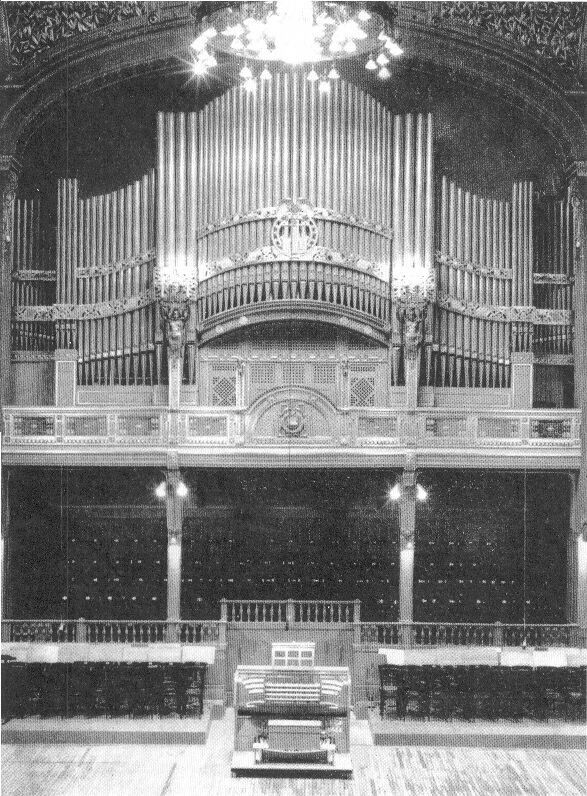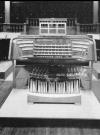Description complète d'orgue sélectionné

Source: Het Orgelblad, september 1969
Budapest, Magyarország (Budapest) - Zeneakadémia (Liszt Ferenc Zeneművészeti Egyetem)
Commune: Budapest
Site Web: http://www.zeneakademia.hu/
Description no.: 2000805.
Bâti par: Heinrich Voit & Söhne (1907)
Données techniques
Composition
I. Manual (C-g'''): Principal 16', Principal 8', Flauto concert 8', Pileata 8', Corne de Chamoix 8', Fugara 8', Dolce 8', Ottava 4', Flauto 4', Ottavino 2', Cornetto 5 fach (8'), Mixtura 4 fach (2'), Basson 16', Tromba 8', Clarino 4', Tuba Mirabilis 8' - transmission.
II. Manual (C-g'''): Bourdon 16', Principal 8', Flute Harmonique 8', Pileata 8', Gamba 8', Chalumeau 8', Salicional 8', Unda Maris 8', Ottava 4', Flauto Tibia 4', Dolce 4', Piccolo 2', Cembalo 3 fach (2'), Acuta 4 fach (2'), Clarinette 8', Tuba Mirabilis 8' - high pressure.
III. Manual (Schwellwerk) (C-g'''): Quintatön 16', Violino Princip 8', Flute d'Amour 8', Pileata Dolce 8', Echo Gamba 8', Aeolina 8', Vox Coelestis 8', Ottava 4', Flauto Traverse 4', Violino 4', Flauto Sylvestre 2', Harmonia Aetherea 4 fach (2 2/3'), Trompette Harmonique 8', Oboe 8'.
IV. Manual (Schwellwerk) (C-g'''): Flauto Pileata 16', Principal 8', Flauto Cuspida 8', Quintatön 8', Bourdon 8', Viola 8', Vox Angelica 8', Praestant 4', Flauto Dolce 4', Flageolet 2', Sesquialtera 2 fach (2 2/3'), Vox Humana 8', Tremolo für Vox Humana, Carillon (Celesta) 4'.
Pedal (C-f'): Grand Bourdon 32' - in Swell III. Manual, Principal 16', Subbasso 16', Bourdonbass 16' - in Swell III. Manual, Violon 16', Harmonicabass 16', Quinta 10 2/3', Ottava Basso 8', Flauto Basso 8', Cello 8', Salicet Basso 8' - in Swell III. Manual, Dolce 8' - transmission, Ottava 4', Bombardo 32', Trombon 16', Fagotto 16' - transmission, Tromba 8', Clarino 4' - transmission.
Accouplements: I. Manual - I. Manual super, I. Manual - II. Manual, I. Manual - II. Manual sub, I. Manual - III. Manual, I. Manual - III. Manual super, I. Manual - IV. Manual, II. Manual - III. Manual, II. Manual - IV. Manual, III. Manual - IV. Manual, Pedal - I. Manual, Pedal - II. Manual, Pedal - III. Manual, Pedal - IV. Manual, Generalkoppel.
Jouer conseils: 3 freie Kombinationen 8', Setzer-Kombinationen 3', 4 feste Kombinationen (per Manual) (p - mf - f - ff) 4', Generaltutti, Tutti ohne Zungen, Tutti Zungen, General Crescendo, Pianopedal II. Manual, Pianopedal III. Manual, Pianopedal IV. Manual, Zungen Ab.

Source: Het Orgelblad, september 1969
Budapest, Magyarország (Budapest) - Zeneakadémia (Liszt Ferenc Zeneművészeti Egyetem)
Commune: Budapest
Site Web: http://www.zeneakademia.hu/
Description no.: 2000805.
Bâti par: Heinrich Voit & Söhne (1907)
| Année | Facteur | Opus | Activité | 1907 | Heinrich Voit & Söhne | 975 | orgue neuf | 1924 | József és fia Angster | conversion | 1967 | E.F. Walcker & Cie. | 5200 | orgue neuf dans buffet vieille | 2018 | Klais Orgelbau | reconstruction |
- In 1905 it was decided to have a large concert organ built for the Main Hall of the Budapest Music College. The organ builder Voit & Söhne was chosen. They built the instrument in two years. It was inaugurated in 1907. The organ had four manuals and a pedal with 74 stops. The action was electro-pneumatic. The prospect of the instrument was designed in Jugendstil, as was the entire building.
- The Angster organ factory converted the organ in 1924. In 1954, another major renovation followed by the Hungarian state organ builder. However, it turned out to no longer function properly, and it kept getting worse. In 1965 it was decided to replace the organ with a new instrument behind the old facade. The German firm Walcker built this organ, that was put into use on September 9, 1967.
- In 2011 the interior of Walcker was removed. The concert hall was restored in 2011-2012, as was the 1907 Voit prospect. Plans were made to reconstruct the Voit organ, many of which many parts, including pipework, wind chests and a bellow) have been traced in other organs in Hungary. They were acquired for the purpose of the reconstruction.
- The reconstruction was carried out by Klais Orgelbau in the years 2015-2018. The organ was inaugurated again on October 22, 2018.
Données techniques
| Nombre de registres par manuel | |
| - I. Manual | 16 (15) |
| - II. Manual | 16 |
| - III. Manual (Schwellwerk) | 14 |
| - IV. Manual (Schwellwerk) | 12 |
| - Pedal | 18 (15) |
| Nombre de jeux total | 76 (72) |
| Transmission des clés | Electropneumatic |
| Transmission des jeux | Electropneumatic |
| Sommier(s) | Voit winchests |
| Hauteur tonale | a' = 440 Hz |
| Température | Equal temperament |
| Presse de Vent | 90 mm (IV. Manual), 100 mm (III. Manual), 110 mm (II. Manual), 120 mm (I. Manual), 150 mm (Pedal), 250 mm (Tuba Mirabilis) |
Composition
I. Manual (C-g'''): Principal 16', Principal 8', Flauto concert 8', Pileata 8', Corne de Chamoix 8', Fugara 8', Dolce 8', Ottava 4', Flauto 4', Ottavino 2', Cornetto 5 fach (8'), Mixtura 4 fach (2'), Basson 16', Tromba 8', Clarino 4', Tuba Mirabilis 8' - transmission.
II. Manual (C-g'''): Bourdon 16', Principal 8', Flute Harmonique 8', Pileata 8', Gamba 8', Chalumeau 8', Salicional 8', Unda Maris 8', Ottava 4', Flauto Tibia 4', Dolce 4', Piccolo 2', Cembalo 3 fach (2'), Acuta 4 fach (2'), Clarinette 8', Tuba Mirabilis 8' - high pressure.
III. Manual (Schwellwerk) (C-g'''): Quintatön 16', Violino Princip 8', Flute d'Amour 8', Pileata Dolce 8', Echo Gamba 8', Aeolina 8', Vox Coelestis 8', Ottava 4', Flauto Traverse 4', Violino 4', Flauto Sylvestre 2', Harmonia Aetherea 4 fach (2 2/3'), Trompette Harmonique 8', Oboe 8'.
IV. Manual (Schwellwerk) (C-g'''): Flauto Pileata 16', Principal 8', Flauto Cuspida 8', Quintatön 8', Bourdon 8', Viola 8', Vox Angelica 8', Praestant 4', Flauto Dolce 4', Flageolet 2', Sesquialtera 2 fach (2 2/3'), Vox Humana 8', Tremolo für Vox Humana, Carillon (Celesta) 4'.
Pedal (C-f'): Grand Bourdon 32' - in Swell III. Manual, Principal 16', Subbasso 16', Bourdonbass 16' - in Swell III. Manual, Violon 16', Harmonicabass 16', Quinta 10 2/3', Ottava Basso 8', Flauto Basso 8', Cello 8', Salicet Basso 8' - in Swell III. Manual, Dolce 8' - transmission, Ottava 4', Bombardo 32', Trombon 16', Fagotto 16' - transmission, Tromba 8', Clarino 4' - transmission.
Accouplements: I. Manual - I. Manual super, I. Manual - II. Manual, I. Manual - II. Manual sub, I. Manual - III. Manual, I. Manual - III. Manual super, I. Manual - IV. Manual, II. Manual - III. Manual, II. Manual - IV. Manual, III. Manual - IV. Manual, Pedal - I. Manual, Pedal - II. Manual, Pedal - III. Manual, Pedal - IV. Manual, Generalkoppel.
Jouer conseils: 3 freie Kombinationen 8', Setzer-Kombinationen 3', 4 feste Kombinationen (per Manual) (p - mf - f - ff) 4', Generaltutti, Tutti ohne Zungen, Tutti Zungen, General Crescendo, Pianopedal II. Manual, Pianopedal III. Manual, Pianopedal IV. Manual, Zungen Ab.
| Autres données des dispositions | |
|---|---|
| Autres dispositions |
The Walcker specification from 1967 was: Hauptwerk (C-c''''): Prinzipal 16', Bourdon 16', Prinzipal 8', Rohrflöte 8', Hohlflöte 8', Gemshorn 8', Oktave 4', Nachthorn 4', Quinte 2 2/3', Superoktave 2', Blockflöte 2', Rauschpfeife 5 fach (4'), Mixtur Major 6-8 fach (2'), Mixtur Minor 5 fach (1'), Trompete 16', Trompete 8', Trompete 4'. Positivwerk (C-c''''): Gedackt 8', Quintadena 8', Prinzipal 4', Blockflöte 4', Oktave 2', Spitzflöte 2', Quinte 1 1/3', Superoktave 1', Sesquialtera 2 fach (2 2/3'), Scharf 6 fach (1 1/3'), Quintcimbel 3 fach (1/3'), Krummhorn 8', Trichterregal 4', Tremolo. Schwellwerk (C-c''''): Gedacktpommer 16', Italienische Prinzipal 8', Querflöte 8', Lieblich Gedackt 8', Vox Coelestis 8' (2 sor), Violoktave 4', Koppelflöte 4', Nasat 2 2/3', Trichterflöte 2', Kornett 3 fach (2 2/3'), Scriari 3 fach (2'), Mixtur 6-7 fach (1 1/3'), Französische Trompete 8', Oboe 8', Vox Humana 8', Clairon 4', Tremolo. Schwellpositiv (C-c''''): Holzprinzipal 8', Nachthorn Gedackt 8', Salicional 8', Gemshorn 4', Konzerflöte 4', Gedacktquinte 2 2/3', Prinzipal 2', Waldflöte 2', Terzflöte 1 3/5', Larigot 1 1/3', Septime 1 1/7', Sifflöte 1', Obertöne 2 fach (2/9' + 2/11'), Acuta 4 fach (1'), Terzzimbel 3 fach (1/5'), Rankett 16', Dulcian 8', Schalmey 4', Tremolo, Campanelli (Harangok). Pedal (C-g'): Untersatz 32', Prinzipal 16', Kontrabaß 16', Subbaß 16', Großquint 10 2/3', Oktav 8', Baßflöte 8', Choralbaß 4', Bauernflöte 2', Rauschbaß 7 fach (5 1/3'), Hintersatz 6 fach (2 2/3'), Mixtur 5 fach (1 1/3'), Posaune 16', Dulzian 16', Trompete 8', Klarine 4', Singend Kornett 2'. Schwellpedal: Lieblich Gedack 16', Spitzgedackt 8', Quintadena 4'. Couplers: Hauptwerk - Positivwerk, Hauptwerk - Schwellwerk, Hauptwerk - Schwellpositiv, Positivwerk - Schwellwerk, Positivwerk - Schwellpositiv, Schwellwerk - Schwellpositiv, Pedal - Hauptwerk, Pedal - Positivwerk, Pedal - Schwellwerk, Pedal - Schwellpositiv. Accessories: 8 Setzerkombinationen 8', 3 freie Pedalkombinationen 3', 4 feste Kombinationen (Tutti, Pleno, Ripieno, Forte) 4', Pleno I. Manual, Pleno II. Manual, Pleno III. Manual, Pleno IV. Manual, Pleno Pedal, Registercrescendo, Zungen Ab. Electric action and slider chests. |
| Références |
|
| Lièns |
https://klais.de/m.php?tx=237 |
 |
